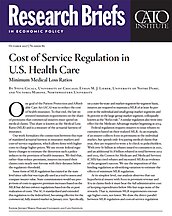Our work formalizes the connection between this type of mandated actuarial fairness in insurance markets and cost-of-service regulation, which allows firms with higher costs to charge higher prices. We use recent federal regulatory changes to estimate the distortion such a policy induces in the provision of health insurance. We find that, rather than reduce premiums, insurers increased their claims costs nearly one-for-one with their distance below the regulatory threshold.
Some form of MLR regulation has existed at the state level since 1980 but was typically used as a tool to assess and compare insurer value. State commissioners would use projections of costs to approve premium increases based on the MLR but did not enforce regulations based on the ex post realization of costs. The ACA standardized and extended this regulation to the federal level, becoming effective for the commercial, fully insured market in January 2011. Specifically, on a state-by-state and market-segment-by-segment basis, insurers are required to maintain a MLR of at least 80 percent in the individual and small-group market segments and 85 percent in the large-group market segment, colloquially known as the “80/20 rule.” A similar regulation also went into effect for the Medicare Advantage market beginning in 2014.
Federal regulation requires insurers to issue rebates to customers based on their realized MLR. As an example, if an insurer collects $100 in premiums in the individual market, but spends only $79 paying medical claims that year, they are required to write a $1 check to policyholders. With over $1 billion in rebates issued to consumers in 2011, and an additional $1.8 billion rebated in total between 2012 and 2015, the Centers for Medicare and Medicaid Services (CMS) has cited rebates and increased MLRs as evidence of the program’s success. We use the imposition of this binding regulation as identifying variation to estimate the effects of minimum MLR regulation.
At its simplest level, our analysis observes that our hypothetical insurer with $100 in premium revenue and $79 in claims finds it must bear the full administrative cost of keeping expenditures below $80 but reaps none of the rewards. That is, minimum MLR requirements encourage higher costs, not lower. We draw the direct parallel between MLR regulation and cost-of-service regulation 2 and show empirically that the 80/20 rule has, indeed, substantially increased insurers’ medical expenditures. While perhaps obvious ex post, this connection has not been established (nor estimated) to date.
Our work therefore contributes to our understanding of both firm response to regulation in the health care sector and to cost-of-service regulation more broadly. Recent empirical work has shown the importance of bias in input choices. In our setting, the regulatory instrument is even blunter than favoring one input over another, and the regulator has no authority to deny reimbursement for “imprudent” expenditures, as they would in the electricity sector, for example. It has also been shown that both providers and insurers respond to such economic incentives: doctors and hospitals change how they treat patients in response to Medicare reimbursement incentives, drug makers charge higher prices to more price-inelastic customers, and insurers free-ride on Medicare reimbursement schedules to economize on negotiation costs.
We measure the impact of the 80/20 rule on MLRs, medical claims per life-year, and premiums per life-year using annual data from 2005–2013 from the National Association of Insurance Commissioners (NAIC). We use a framework that compares changes in outcomes over time between insurers with historically low MLRs versus those who were persistently in compliance with the rule before it took effect. We show that this regulation is associated with an abrupt increase in MLRs for “treated” firms that is approximately one-for-one with their distance from the mandated MLR minimum. This increase was accomplished almost entirely by increases in medical claims expenditures. Our preferred estimates show a 7 percent increase in claims in the individual market for firms that were previously out of compliance; in the group market, we estimate a 2 percent increase in claims. We find little evidence of a reduction in premiums in either the individual or group markets. We find suggestive evidence that insurers cut administrative spending when the regulation was binding.
We note that, while our results show impacts of MLR regulations that are sharply divergent from their original intention of lowering costs, it is difficult to make a statement about net welfare. The potential presence of moral hazard in the consumption of insured health care would suggest that these costs exceed policyholder willingness to pay for them. On the other hand, if insurers were inefficiently restricting the actuarial value of plans, this expansion in claims has a positive net value to society insofar as it moves equilibrium toward the intersection of the marginal cost and marginal willingness to pay for insurance. Even if the entire increase in claims costs were due to higher provider prices with no change in quantities (a transfer to providers), one would still need to account for the benefit to insurers of less price-reducing negotiation effort. Instead of making net welfare statements, our goal is to take a first step in characterizing the nature and magnitude of the problem so that the tools developed elsewhere for such settings might be brought to bear in the future.
NOTE
This research brief is based on Steve Cicala, Ethan M. J. Lieber, and Victoria Marone, “Cost of Service Regulation in U.S. Health Care: Minimum Medical Loss Ratios,” NBER Working Paper no. 22648, September 2016, http://www.nber.org/papers/w23353.
